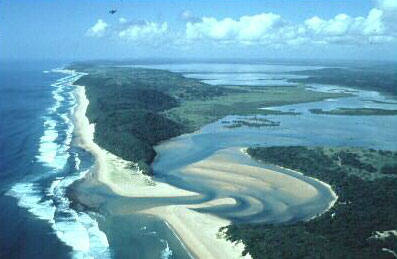
(Courtesy of Ricky Taylor)

|
Kosi Bay is located in South Africa. It is bounded by the country of Mozambique in the north and the Indian Ocean in the east, the western border consists of the lakes of the Kosi system and in the north west, the system includes a narrow strip of land that is around the margins of the lakes. The Kosi system is composed of four interconnected lakes; the Makhaqulani, Mpungwini, Nhlange and Amanzimnyama. There is a broad channel that leads to the Indian Ocean, the lakes are separated from the ocean by forested sand dunes. There are two rivers that enter the Kosi system, the Sidhadla River which receives water from 12 tributary systems and then enters Lake Amanzimnyama and the Nswamanzi River which collects water from 9 tributary systems and then enters into Lake Nhlange on its western shore. The maximum depths vary within each lake, they range from 31 meters (~100 feet) to 8 meters (~26 feet). The estuary itself has a maximum depth of only 3 meters (10 feet). Lake Amanzimnyama is the shallowest of the lakes with a maximum depth of 2 meters (6.5 feet). The Kosi system is known for its clear water, the Secchi test show values between 4.2 meters (~14 feet) and 7 meters (23 feet). The mouth of the estuary is subjected to regular and strong tidal movements and the mouth of the estuary varies in size with every tide. The width of the estuary is generally 20-50 meters (65-165 feet) but can vary in width from 5-100 meters (16-328 feet). Kosi is a unique estuary in that it has a rocky reef inside the mouth. Eighty percent of the fish species that are found in the Kosi estuary reside here. The species found within the reef are of typical tropical Indo-Pacific reef fauna. Examples of fauna include, surgeonfishes, damselfishes, butterflyfishes, and wrasses. The Kosi system experiences cyclones that can cause a considerable rise in sea level over a short amount of time. This drastic water level rise can cause the death of plant communities. Another serious problem that affects the Kosi system is the use of DDT, the malaria controlling spray is contaminating the Lakes. The pesticide is apparent in the sediments of the lakes and can cause contamination in fish. The Kosi system has social and cultural values that make it important to the community that lives within it. Zulu fishermen have used the system for many years, they use fish traps and traditional spear fishing to harvest numerous fish species. Local inhabitants collect and consume fruits that are indigenous to the area surrounding the estuary. Raphia palm leaves are collected and used in the construction of rafts and houses. In addition to its natural resources, local communities use the lakes and oceans for cultural and religious activities.
|